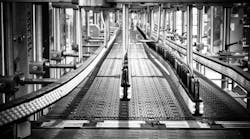The Evolution of the Food Conveyor: Metal vs. Plastic
Product Evolution is a cycle where the product changes in terms of features, functionality, quality, offerings, technology, etc. over time to better serve its purpose and customer needs. Product evolution exists for every product type whether a mobile phone, a television, a bike or a conveyor system.
Most fascinating is the evolution of one product feeding the cycle of another. You’ll know what we mean later in this article.
Plastic Food Conveyors Began With the Evolution of the Conveyor
In the last hundred years, food conveyors have evolved in their purpose from a simple transport method to a fundamental requirement to keep up with the mass production of food required to feed the world’s growing population. Conveyors of the early centuries were made of steel, aluminum, wood, and other products readily available at the time.
At some point in the past decades, metal—predominantly stainless steel—became a front runner to other materials for food conveyors. Just as our televisions have evolved from a mechanical device to a digital one, food conveyors have gone through an evolution of their own.
Dynamic Conveyor was founded in 1991 on the design of a modular conveyor system called DynaCon for the injection molding industry. The plastic conveyor system modules—often compared to building blocks in their ease of re-arranging—allowed parts manufacturers to transport parts from molding equipment to the next step in the manufacturing process—and offered the ability to reconfigure the system as the operational demands changed.
A Modular, Food Grade Conveyor System – Made With Industrial Plastics
As the popularity of this modular-style conveyor system grew outside of the injection molding and general manufacturing industry, food manufacturers inquired about whether a similar modular system could meet the demands of the food industry. With the Company’s DynaCon line not designed to meet sanitary design standards, and strong market demand from customers, Dynamic Conveyor used its engineering expertise to design and build an easy-to-clean, food-grade, full washdown sanitary conveyor for the food processing and packaging industry—and it was made from plastic.
The food conveyor evolved. This new product line was called DynaClean and was introduced in 2012 to food manufacturers and others needing sanitary conveyor systems.
To be able to meet the continuous and rigorous demands of the food processing industry, the DynaClean food-grade conveyor is constructed of industrial-grade thermoplastics. Conveyor sidewalls are constructed from High-Density Polyethylene (HDPE) & Very High Molecular Weight Polyethylene (VHMW). Belt supports use Ultra High Molecular Weight Polyethylene (UHMW), while internal cross bars, shafts, and all fasteners are stainless steel.
What's the Advantage of Using Industrial-Grade Plastics?
The use of industrial-grade plastics is very common in the food processing industry. Virtually all other conveyors that have a steel frame use these same plastics for belt paths, retainers, and supports. Dynamic Conveyor uses industrial-grade plastics throughout the conveyor for the following reasons:
- Ease of cleaning
- Durability and high impact resistance, which reduces the likelihood of introducing metallic shavings into the food stream
- They do not absorb moisture or bacteria
- Considerable design flexibility
- Design simplicity and toolless disassembly, both of which are critical to allow for proper and efficient cleaning
How Does the Plastic Sidewall Construction Hold Up?
Historically, plastics were not comparable to the strength characteristics of metal. However, today’s industrial grade thermoplastics perform as well, and in many cases better than metal, on strength, rigidity, and elasticity. These plastics tend to have higher strength-to-weight ratios as well as strength to stiffness ratio compared to metals.
Dynamic Conveyor’s engineering team uses Finite Element Analysis (FEA) to predict how DynaClean conveyors will perform in specific applications. The evolution of thermoplastics has aided in the evolution of many products, including DynaClean.
DynaClean plastic food conveyors stand up to the harshest cleaning methods including high-pressure/high-temperature washdowns and harsh cleaning chemicals.
Due to the superior chemical resistant properties of the HDPE, UHMW, and VHMW plastics, DynaClean conveyors stand up to many cleaning chemicals better than stainless steel frame conveyors over the long term.
Most often the evolution of a product comes from the demands of the customers. At Dynamic Conveyor, we listen to our customers and continue to look for new ways to engineer conveyor systems to meet their industry-specific needs. As materials evolve, so will our conveyor product lines and we intend to be at the forefront of innovation throughout the evolution of conveyors.
Learn of the many DynaClean customer successes in the food industry.
Marcie Palmer is the Marketing Manager at Dynamic Conveyor. After graduating from Aquinas College with a degree in Business Administration, Marcie has experience in almost every area of business including HR, sales, operations, and marketing gaining unique and valuable perspectives along the way. She spent 15 years in the distribution industry where she grew marketing departments from scratch. Marcie established and executed on sales and marketing strategies that developed strong brands and capitalized on all channels of marketing including email marketing, blogs, website management, SEO, SEM, social media, seminars and events, trade shows, and more.
















